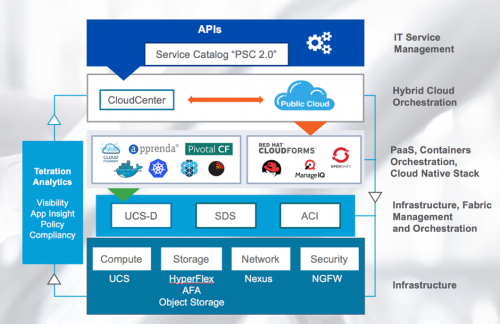
Build, run and manage IT successfully in a software defined future
Software, in its many guises, definitely is the new currency at the moment. I’m not just talking about application development – which of course is vital in being able to Digitally Transform, but before you can even think about that part, lets talk about software in the context of using it effectively to simplify the management and operation of IT.
Just look at the explosion of software defined everything – from networking and storage, automation and cloud management, to the monitoring of applications and infrastructure. Getting the software piece right across your Data Centre brings agility and lower operational costs. It also ensures the systems we rely and depend on give optimal performance and highest availability, they can tell you what is going on in real time and recover quickly in the event of a fault.
Software ultimately has to run on something however. And that something is infrastructure. Yes, there are software solutions that run independently regardless of the underlying infrastructure, but that, in my opinion, isn’t always the right methodology when it comes to certain use cases.
Take Software Defined Networking (SDN) as an example. Running a separate SDN solution over ‘any old’ infrastructure adds dual layers of management and configuration, one for the software and another for the hardware. Questions therefore arise around the consistency of outputs from instructions sent by the software to the hardware layer.
Ensuring the software and hardware elements are designed to work together reduces the amount of management silos and means guaranteed consistency of what the software is asking versus what the infrastructure can deliver. Software, therefore, should be there to help us, not just there to add more complexity.
To show you first-hand how we achieve this, we’re taking the Cisco Data Centre architecture on a UK tour throughout June and July as an update to the Public Sector across three events. These events are for technical decision makers and senior users of technology.
You can register here to attend the first event in Newcastle, being held at Newcastle United FC Conference and Events Centre, Newcastle on 15th June.
Data centre software innovation
With a range of software components within the Cisco Data Centre architecture, our conversations go way beyond just switching and servers. So, it still surprises me that not everyone recognises this fact.
Consider the software that sits on top of our UCS Compute and Nexus Switching Infrastructure stack:
1. Data Centre Orchestration and Management, for example, comes in the form of UCS-Director (or Data Centre Director as I think it should have been called, due to its ability to manage everything Cisco and 3rd Party). Allowing you to orchestrate functions across Network, Compute, Hypervisor, Bare Metal, Containers, Storage and even provide automation for things like spinning up virtual machines.
2. ACI is our SDN layer that goes hand in hand with the Nexus 9000 fabric – removing manual configuration of the network, delivering whitelist security policies, micro segmentation and application policies and health check monitoring to ensure the best performance for applications across the network.
3. CloudCenter Multi-Cloud Management software enables modelling of applications and workloads to move between clouds (public and private) based on performance vs. cost, all under the security, governance and control policies that are set by IT.
4. Prime Services Catalogue is an IT as a Service Catalogue offering public cloud like self service capabilities for users to request IT and other services, such as phones, software etc., with business process, chargeback reporting and business process approval automation all baked in.
5. Tetration Analytics (and our new acquisition AppDynamics) are solutions that monitor every packet, flow and line of code – giving real-time information back to the IT team regarding application dependencies, performance and security, while monitoring of application performance down to each line of code.
Our offering truly is end to end, open and not driven by choice of just hypervisor alone. We offer software combined with infrastructure; world-class support in Cisco TAC; a vast partner landscape; and 3rd party technology partners that provide integrations openly via APIs into our ‘stack’- such as software defined storage, SAN Storage, Security Products, multiple hypervisors, PaaS and Containers. This all makes Cisco’s data centre portfolio stand out when it comes to any organisation thinking about the best way to build, run and manage IT for the future.
Change is a constant
Naturally, technology is always changing and evolves at blistering pace. I have the great privilege in my role to cover Cisco’s Data Centre Architecture for the UK Public Sector. It means I’m involved in some large and very complex projects looking to transform the IT landscape for systems and applications that directly affect our day-to-day lives.
In Healthcare, for example, where technology underpins the systems that keep hospitals and medical services running. In Education, where technology is being used to enable our children to learn more effectively and efficiently. And in Research, where vast data sets across multiple fields are being analysed to help make the world a better place.
Never has technology been more prevalent in our lives, and this trend and dependency on technology will only continue to grow.
So, it’s fair to say; everything now runs on IT and when IT runs well, so does everything else. It’s also fair to say that every organisation is different, but all have the desire to achieve one thing: to ensure IT systems run well and problem free.
During our UK roadshow, we’ll cover the full data centre stack with input from our partners (Intel, Docker and Engage ESM) and show you how to successfully build a reliable, performant, policy-driven and inherently secure data centre.
Register here for the first event in Newcastle. Or join us at Trent Bridge on July 6, or Celtic Manor in Newport on July 13 201
Tags:




